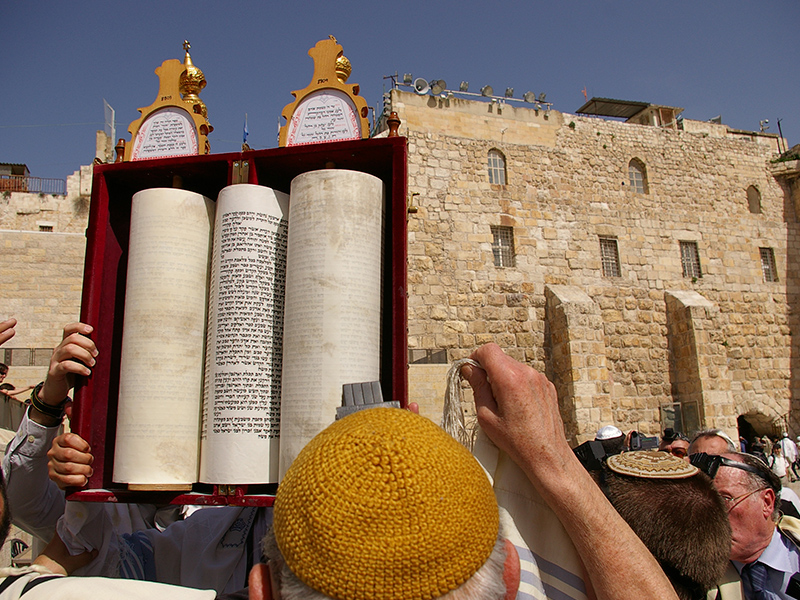The next time you’re called up to the Torah and are concerned about reciting the blessings perfectly, you should know you have it easy. The sofer, the scribe who wrote that Torah, had to inscribe all 304,805 letters perfectly. We recently read on Shavuot about the giving of the Torah at Mount Sinai. So today, we’ll look at the incredible amount of work that goes into creating Torah scrolls – an amazing creation that combines the art of calligraphy, the fine detail of Halachah and the secrets of Jewish mysticism.
A Jewish scribe is called a “sofer STaM.” Sofer because he literally counts the letters to make sure the work is perfect. STaM is a acronym for the major areas of work: sifrei Torah, tfillin and mezuzot.
Today’s sofrim have some pretty high standards to adhere to. According to a Midrash, before Moses died, he wrote 13 Torah scrolls. He gave one to each tribe and placed the 13th scroll in the Holy Ark along with the tablets from the Ten Commandments “so that no one dare falsify the text of the scroll.”
Actually the 613th and final commandment is to write one’s own copy of a sefer Torah. If you don’t happen to be a scribe, there are many sofrim who will be happy to write one for you. But if you don’t have $35,000 (US) or more to spare, you can still fulfil the mitzvah by contributing toward the writing of a Torah or just pitching in for the cost of a letter or two.
For example, $5 will buy you a letter in a Torah that will be will be transferred for use by Israel Defence Forces soldiers. Kids can buy a letter for a buck in a Torah being written on their behalf.
There are complex laws concerning the shape of each of the 22 letters of the Hebrew alphabet (as well as the five final letters.) To get an idea of how complicated the calligraphic laws can be, this site has a graphic of each letter. The letter aleph has three distinct parts and 10 laws concerning its form. Even the yud, the smallest letter of the alphabet, has eight distinguishing features.

Some of those features have mystical origins. Many letters are adorned by crowns (“taggim”), which are much more than ornamental squiggles. The kabbalistic book, the Zohar “teaches us that the right tag, crown, represents God’s attribute of mercy, while the left tag represents His attribute of justice. The right tag has to be taller than the left one, symbolizing God’s mercy rising above His justice.”
The work of sofrim may be mystical, but there are also numerous laws and traditions that must be followed scrupulously in order to create a kosher Torah. When you take a peak into the The International StaM Forum, you can see what kinds of questions are being shared by 82 scribes from around the world. Many include photos of questionable calligraphy and queries about whether they are kosher. But I also like these:
- What is the best humidity to store a sefer Torah? (Ideally, 45 to 55 per cent humidity. Sixty per cent is still good, but no more.)
- Where can you get kosher hide glue in New York?
- Is a sofer allowed to listen to music or Jewish lessons while working? (Some said no. Others said quiet, classical music is permitted and assists in concentration.)
The most impressive sofer site that I have come across belongs to Mordechai Pinchas, who hails from Essex in southeast England. His Diary of a Sofer tells of his love of calligraphy and his journey to becoming a sofer. Although some challenges faced by sofrim haven’t changed in centuries, contemporary scribes face some very modern tests.
Here’s what happened when Pinchas set out to create the kosher ink used by scribes. “One recipe (there are several) calls for iron sulphate crystals and tannic acid. My mentor told me that I could get them at the chemist, so I went to the one around the corner. ‘I know this might sound bit odd,’ I say to the pharmacist, ‘but I would like to buy some iron sulphate and tannic acid.’ He informs me that it is now illegal to buy such chemicals over the counter, as I might be making a bomb!” Pinchas eventually convinced the kind chemist that he’s no terrorist and went on to complete his sefer Torah.
If you want to have your hand in creating a Torah but you prefer thread and fabric to ink and parchment, you can volunteer in the worldwide needlepoint project, Stitch by Stitch. The goal is to recreate in sofer-style, the entire text of the Torah using volunteer artisans from around the globe.
The site includes information about participation in the 1,463-panel artistic project and many needlepoint tips. Here’s a piece of advice from the organizers: although you may be tempted, “Please don’t kiss your stitching.” It can leave schmutz and lipstick.
